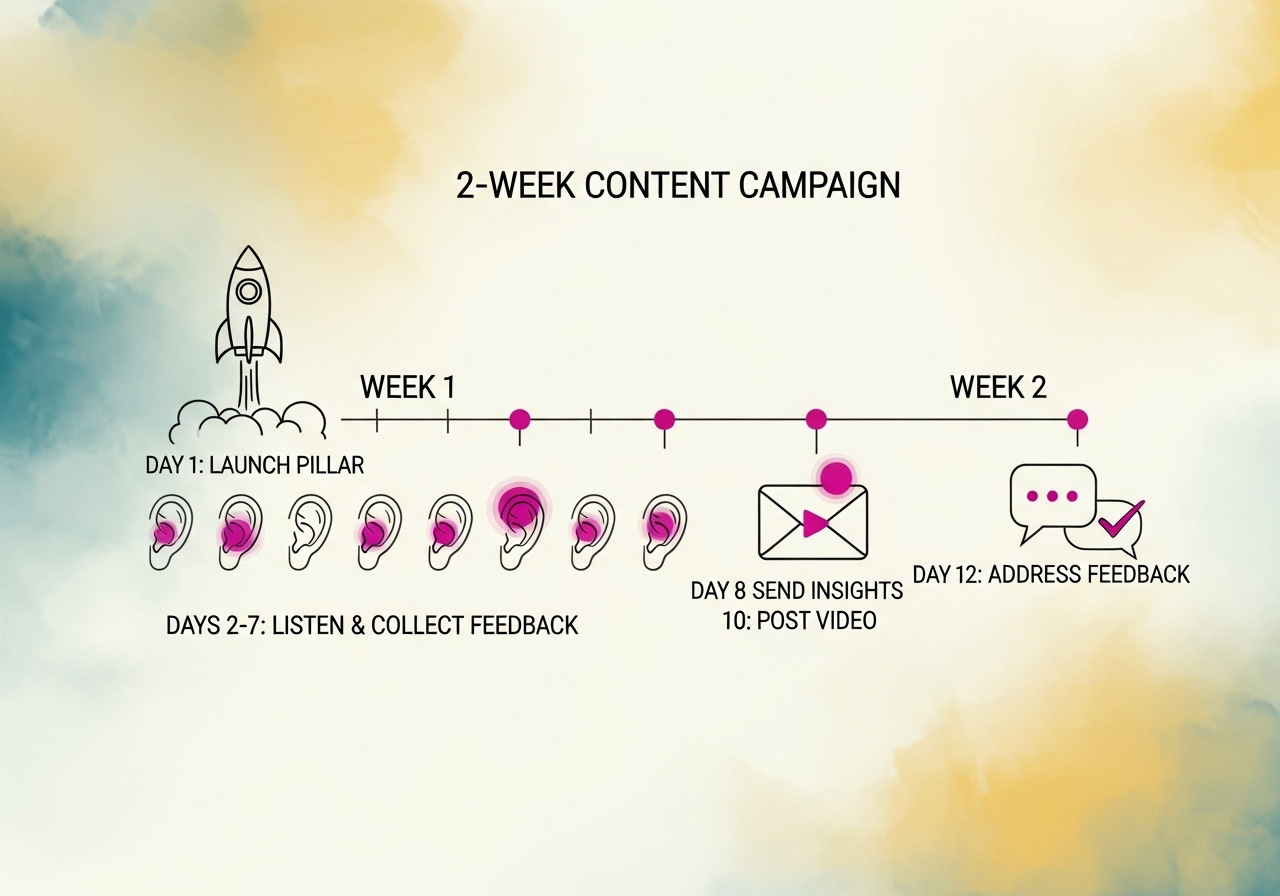Stop hitting "Publish" and walking away
A piece of content without a distribution system is just a very expensive diary entry
Welcome to today’s edition of ROBOTS ATE MY HOMEWORK. Today we’re committing a cardinal sin of the creator world: we're going to stop killing our creation.
I need to confess to a crime. It’s one I’m sure you’ve committed, too. You spend 15, maybe 20 hours crafting the perfect, most insightful blog post. You wrestle with every sentence. You find the perfect data. You hit 'publish,' blast it out in a single tweet, maybe an email and then immediately panic about what you’re going to write next week.
This is an act of marketing malpractice. You forged a weapon and left it on your desk to hold down papers.
Most founders and marketers are trapped on this content treadmill, a cycle of creation that leads directly to burnout. AI has made the wheel spin even faster, but most people are just using it to create more assets that simply die faster.
We are going to do the opposite. With a caveat: that doesn't just mean a smarter distribution system. It starts with a smarter strategy. A great distribution system can't save a bad idea.
(7-minute read)
Today, we're going to cover:
A step-by-step playbook for turning one great article into a two-week marketing campaign built on the principle of asymmetric leverage.
How to select a "Pillar" piece that actually anchors a campaign.
The critical mindset shift from laborer to strategist
A ready-to-use prompt for turning articles into compelling stories for LinkedIn.
🤖 ROBOT REPORT CARD
We’ve been conditioned to believe that the answer to growth is always "more." More posts, more articles, more videos, more content. This is a lie. The primary lever for growth is distribution. The objective is to get your best ideas seen repeatedly.
Think of it this way: a 10/10 article seen by 100 people has an impact score of 1,000.
A 7/10 article seen by 10,000 people has an impact score of 70,000.
Quality is the base number, but distribution is the multiplier. You can't win without the multiplier.
This content treadmill is an inefficient engine of burnout where the only goal is to feed the algorithm something, anything, before it forgets you exist. Your best work gets seen once and then dies a quiet death in your archives.
We need to stop this.
The solution is a smarter workflow that treats distribution with the same respect we give creation. That’s called Content Atomization.
Here’s how it works.
Step 0: Build your pillar on a real strategy
Before you even write anything, how do you know your pillar idea is worth the 20-hour investment? A pillar piece must be built on a strategic foundation. That means understanding:
Market reality: What are people actually searching for? What is already winning on Google?
Your business context: How does this topic serve your business goals and reflect your unique point of view?
An expert framework: What structure will make this content outperform the competition?
Once you’ve got the foundation ready, you’re all good for step 1!
Step 1: Select your "Pillar" piece
A pillar piece is a significant asset you've already invested heavily in:
A deep-dive blog post
A webinar recording or transcript
A podcast episode transcript
A data-driven report or case study
A true pillar piece meets these three criteria:
It has a point of view: It doesn't just summarize facts; it makes a bold, defensible argument. It challenges a common belief.
It's comprehensive: It’s a definitive guide, a deep analysis, or a cornerstone philosophy. A reader should walk away feeling like they've truly mastered a concept.
It's timeless: The core ideas will be just as relevant in six months as they are today. It’s not tied to a fleeting news cycle.
Before you commit to writing thousands of words, run your idea through this simple test. Ask yourself:
Can I explain the core argument to a colleague in 30 seconds? If they shrug and say "so what?" your idea doesn't have a strong enough point of view yet. A true pillar piece makes someone say, "Huh, I never thought of it that way."
Can I mentally brainstorm at least 5-7 smaller "atoms" from this idea right now? Think of different angles or contrarian takes. If you can't easily imagine how it will break down into smaller pieces, it might not be good enough to anchor a full campaign.
Will I still be proud to have this on my site's homepage in six months? Or will it feel dated?
The goal is to choose one high-value asset that represents your best thinking. This is the sun; everything else we create will be a planet orbiting it 🌎
A critical warning: This system amplifies what's already there. It cannot make a weak argument strong or a boring article interesting. It can only take your best work and give it the audience it deserves.
Step 2: Feed the machine
Don't just dump a messy transcript into your AI of choice. Your job is to give it a clear and high-quality brief. Prep the raw material for it.
For text: Quickly scan and clean up any obvious formatting errors.
For transcripts: Run a find-and-replace for filler words ("um," "ah," "like"). More importantly, add speaker labels (Mia:, Guest:) to give the AI crucial context.
Before you unleash the main prompt, prime the AI with a simple instruction:
I am giving you the full text of a long-form article. Your task will be to analyze it and break it down into smaller content assets. First, read the entire text below and simply respond with "Ready" once you have processed it.This small step acts like a mental reset, ensuring the AI has fully ingested the content before you give it the complex task of atomization.
Step 3: The "Atomization" prompt
This prompt is the engine of the system.
Asking an AI for a 'summary' is a demand for intern-level work. You are a strategist who gives the AI a role and specific, high-value deliverables. AI is fundamentally a pattern-recognition engine, so we're asking it to spot the core patterns of your argument and re-format them for different contexts.
Use this master prompt.
CONTEXT:
My company is [Company Name]. We sell [Product/Service] to [Target Audience]. Our brand voice is [e.g., Authoritative but approachable, witty and irreverent, deeply technical and precise]. Do not use overly complex jargon unless it's explained.
TASK:
You are a world-class content distribution specialist for a tech startup. Your audience consists of savvy founders and marketers. Take the following pillar piece of content and "atomize" it into the following assets for a multi-channel campaign. Maintain our brand's confident and authoritative tone.
- Five provocative tweets: each should focus on a single, counter-intuitive idea from the text. They should be designed to start a conversation, not just state a fact. End each with a question.
- One engaging LinkedIn post: start with a strong, relatable hook. Use short paragraphs and white space. Include 3-5 relevant hashtags.
- A 3-part teaser email sequence:
Email 1 (the problem): focus on the core pain point the article solves. Use a story or a startling statistic from the text.
Email 2 (the insight): share the single biggest "Aha" moment from the article. Give away real value.
Email 3 (the solution): briefly link the problem and insight, then drive traffic directly to the main pillar piece.
- A 60-second video script (TikTok/reel): structure it for vertical video. Hook, three quick points with visual cues in brackets [like this], and a call to action.
- A guest post outreach summary: write a 100-word summary of the article's core argument, framed as a pitch for a guest post on a related marketing blog. Highlight why their audience would find it valuable.Step 4: Schedule and distribute
Don't just schedule and forget. Think of this as a two-week campaign. Your goal is to provoke a response by repeatedly exposing your audience to a challenging idea.
Week 1 (launch & listen):
Your only goal in the first 72 hours is to achieve escape velocity. You need to give your idea enough force to break out of your immediate orbit and into someone else's.
Day 1: Publish the pillar piece. Send Email #1 (The problem). Post the LinkedIn update and two of the sharpest tweets. Tag anyone you mentioned or quoted. Your goal today is maximum initial exposure.
Days 2-7: This is the critical "Listen phase." Your job is to stop broadcasting and start monitoring. What questions are people asking in the DMs? What are the strongest objections? Where is the confusion?
You don't need fancy tools for this. Your listening toolkit can be as simple as:
1) LinkedIn/Twitter notifications
2) A simple spreadsheet where you categorize feedback into 'Questions,' 'Objections,' and 'Praise.'
Week 2 (amplify & analyze):
The internet has amnesia. Week 2 is designed to combat it by re-introducing your idea from a new angle, using the feedback you gathered.
Day 8: Send Emails #2 (The insight) and #3 (The solution). Post the remaining provocative tweets. You're now speaking to a more informed audience, so you can go deeper.
Day 10: Post the Reel/TikTok video. It's a different format for a different mode of consumption, capturing people who would never read a long-form post.
Day 12: Feed the best questions and objections from Week 1 back into your AI. Use this simple prompt:
Based on these reader comments, what is the single biggest point of confusion? Draft a short, clear LinkedIn post that addresses it directly and links back to the original article for more context.
You've now closed the loop. You started a conversation, listened to the response, and used it to create even more value. This is how you build an intelligent machine that works for you.
💡 A NEW CONCEPT FOR YOU
This machine produces one thing: Asymmetric Leverage.
Leverage is a simple physics concept: getting a disproportionate output for a given input.
Archimedes said, "Give me a lever long enough and a fulcrum on which to place it, and I shall move the world." This gets quoted in every marketing blog, but everyone misses the point. The lever isn't the content; the complete system is the lever. The fulcrum is your best idea.
But that system has two parts:
Strategic foundation: Creating a pillar idea you know can win.
Systematic distribution: Ensuring that winning idea gets seen.
Most people fail because they only do one or the other. They have a great idea with no distribution, or they have a distribution plan for a piece of content that was never going to work in the first place.
In content, most of us operate with no leverage at all.
Symmetrical effort: Spending 20 hours creating and 20 minutes distributing means your asset immediately begins to decay.
Asymmetric leverage: Spending 20 hours creating a pillar post and then 2-3 hours using an AI-assisted system to atomize and distribute it across ten channels for two weeks is a wildly disproportionate return.
The most effective founders operate on a different axis entirely: the hunt for leverage. Content atomization is one of the most powerful, accessible levers a lean team has.
It allows you to move a massive object, like your content's reach and impact, with a small, focused application of force.
✨ ONE MORE THING…
The most focused application of that force is turning logic into a story.
Articles are inert. Stories are contagious. A story is far more compelling than a list of bullet points.
Here’s a quick prompt to do exactly that.
Take this article [paste text]. Turn its core argument into a compelling, 3-act story suitable for a LinkedIn post.
Act 1: The relatable problem everyone in the industry faces.
Act 2: The surprising or counter-intuitive insight that changes the perspective on the problem.
Act 3: The actionable takeaway or new way forward."And if you want to see a master of this "create once, distribute forever" model in the wild, go study Justin Welsh. He has built a massive audience on LinkedIn and Twitter by atomizing the same dozen core ideas into hundreds of different formats and stories. He proves the thesis: success is a function of leveraging your best ideas, not simply having more of them.
So, here's my question for you.
Right now, what's your approximate ratio of content creation time vs. distribution time? (e.g., 90% creation / 10% distribution, 50/50).
I’d love the data :)
Here's to making your best work work harder,
Chief 🤖 at ROBOTS ATE MY HOMEWORK







💯Whenever I talk with clients about creating new content, I always ask how they’re planning to distribute it. If the answer is something along the lines of “post it on our website and pray,” I suggest pausing until they have a plan. Otherwise, I know I’ll hear from them later with questions like, “Why isn’t anyone reading our post?”
Yes, distribution IS queen! And we all forget it to fall back into the content hamster wheel.
Thanks for the great prompts. I will give them a try.